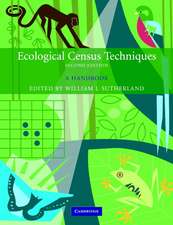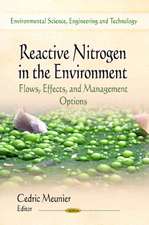A Centennial History of the Ecological Society of America
Autor Frank N. Egertonen Limba Engleză Paperback – 23 oct 2019
Beginning with the society's inception, the book describes the difficulties faced early on and ways in which it expanded. It tracks the society’s progress from the early years when female ecologists were few and inconspicuous to today when they are equally conspicuous as men, and there are as many or more female graduate students in ecology as male. ESA now has members from all around the world, and its journals contain contributions from around the world.
Like all sciences, ecology began with simple questions that led to fairly simple answers. But, as ecological sciences progressed, complexity emerged in both questions and answers and the ESA has documented that process along the way. This book describes important initiatives such as the International Biological Program, the Long Term Ecological Research Network, and establishing new journals, as well as recent programs including the National Ecological Observation Network. With numerous illustrations, photographs, charts, and diagrams, the book lets you explore the early beginnings of ESA as if in conversation with its founders and appreciate the early work and achievements in the field.
| Toate formatele și edițiile | Preț | Express |
|---|---|---|
| Paperback (1) | 492.37 lei 43-57 zile | |
| CRC Press – 23 oct 2019 | 492.37 lei 43-57 zile | |
| Hardback (1) | 1281.24 lei 43-57 zile | |
| CRC Press – 20 mai 2015 | 1281.24 lei 43-57 zile |
Preț: 492.37 lei
Preț vechi: 579.25 lei
-15% Nou
Puncte Express: 739
Preț estimativ în valută:
94.21€ • 98.63$ • 77.96£
94.21€ • 98.63$ • 77.96£
Carte tipărită la comandă
Livrare economică 07-21 aprilie
Preluare comenzi: 021 569.72.76
Specificații
ISBN-13: 9780367377632
ISBN-10: 0367377632
Pagini: 292
Dimensiuni: 156 x 234 x 15 mm
Greutate: 0.54 kg
Ediția:1
Editura: CRC Press
Colecția CRC Press
ISBN-10: 0367377632
Pagini: 292
Dimensiuni: 156 x 234 x 15 mm
Greutate: 0.54 kg
Ediția:1
Editura: CRC Press
Colecția CRC Press
Public țintă
General and Professional ReferenceCuprins
Ecological Society of America History: Introduction. 1914 to 1929: Origins. 1930 to 1944: Challenges. 1945 to 1959: Expansion. 1960 to 1974: The International Biological Program (IBP), The Institute of Ecology, and Others. 1975 to 1989: The International Biological Program (Concluded), the Long Term Ecological Research (LTER) Network, Ecosystems, Profeßional Certification, and Gender. 1990 to 2004: New Journals, the Sustainable Biosphere Initiative (SBI), Strategies for Education in Ecology, Development, and Sustainability (SEEDS), and More. 2005 to 2015: A Sustainable Biosphere and the National Ecological Observatory Network (NEON). ESA History: Conclusions. Appendix A: Ecological Society of America (ESA) Officers. Appendix B: Seven of the ESA Awards. ESA Bibliography.
Notă biografică
Frank N. Egerton studied biology as an undergraduate at Duke University, and then studied ecology for a year at North Carolina State University, Raleigh, before moving to the University of Wisconsin-Madison, where he earned a Ph.D. in history of science. He taught introductory biology at Boston University for three years, then spent four years at the Hunt Institute for Botanical Documentation, Carnegie-Mellon University, where he edited Edward Lee Greene's Landmarks of Botanical History (2 vols., Stanford University Press, 1983). He moved to the University of Wisconsin-Parkside in 1970 and taught history of science and environmental history until he retired in 2005. He has also published Hewett Cottrell Watson: Victorian Plant Ecologist and Evolutionist (Ashgate, 2003) and Roots of Ecology: Antiquity to Haeckel (University of California Press, 2012). As an emeritus professor, he continues to write an online history of ecology in the ESA's quarterly Bulletin.
Descriere
Celebrating its 100th anniversary in 2015, the Ecological Society of America (ESA) is currently the largest professional society devoted to the science of ecology. Divided into seven chapters, this book is an institutional history of the ESA. Beginning with the Society's inception, it describes the difficulties faced early on and ways in which it expanded. It describes important initiatives such as the International Biological Program, the Long Term Ecological Research programs, and establishing new journals, as well as recent programs including the National Ecological Observation Network.














